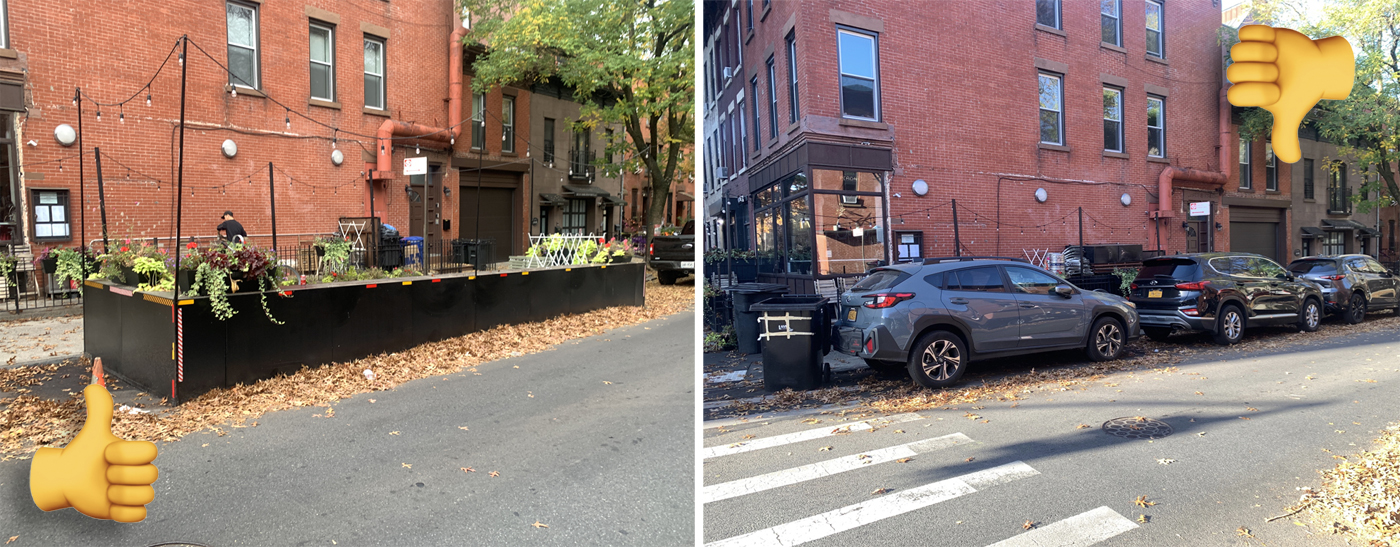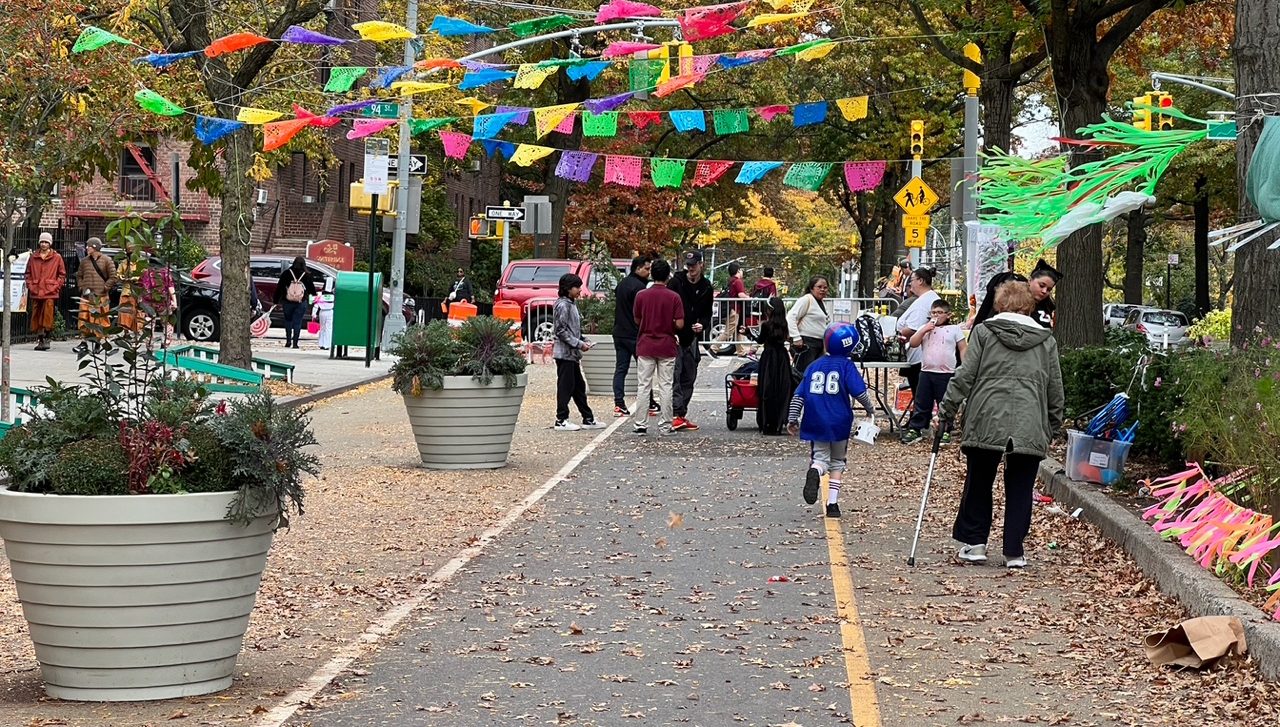Select Bus Service on Woodhaven and Cross Bay Boulevards is coming to Queens in two phases. The first round, due early this fall, will bring nearly two miles of painted bus lanes and a road diet for service roads along more than a mile of Woodhaven Boulevard [PDF]. DOT has said it will release a design for the second phase later this fall.

We don't know yet whether DOT will start to make good on Bill de Blasio's campaign promise to build "world-class" Bus Rapid Transit. But a 2009 study of Woodhaven Boulevard offers a taste of the most basic BRT improvements the agency could propose, plus a cautionary tale for advocates.
The route DOT and the MTA are studying for SBS stretches nearly 14 miles from Woodside to the Rockaways, with the initial improvements focusing on a shorter stretch of Woodhaven Boulevard.
The agency will be adding offset bus lanes, running in each direction next to the parking lane, from Eliot Avenue to Metropolitan Avenue -- about 1.4 miles, or one-tenth of the total project corridor. These lanes will be in effect only during rush hours, from 7 to 10 a.m. and from 4 to 7 p.m. The southern end of the new bus lanes is immediately north of a bridge over Long Island Rail Road tracks, where Woodhaven has three car lanes in each direction. By reducing the number of general traffic lanes north of this pinch point to the same number as the bridge, DOT can demonstrate how Woodhaven functions during rush hours with less space for cars and more for bus riders.
The second section of bus lanes covers slightly more than a half-mile in Ozone Park. There, curbside bus-only lanes will replace parking as Woodhaven and Cross Bay Boulevards approach the complex intersection of Rockaway Boulevard and Liberty Avenue, where many bus riders transfer to the A train. Like the bus lanes north of Metropolitan, these lanes will be in effect from 7 to 10 a.m. and 4 to 7 p.m., except for the final block of each approach, where the lanes will be for buses only between 7 a.m. and 7 p.m.
According to DOT's presentations, the agency expects the first phase to improve bus speeds by about 10 percent [PDF] on the sections with bus lanes. The bus lanes are unlikely to be camera-enforced, since state law allowing the use of cameras restricts them to just one Select Bus Service route in Queens, and DOT has already said that it will use cameras on the M60 SBS route, which runs through Astoria to LaGuardia Airport.
Advocates said the first round of improvements make sense as an incremental step on the way to something bigger. "Eventually, everyone could benefit from comprehensive solutions like center-median bus lanes and off-board fare collection. But it won't happen overnight," said Jess Nizar, senior organizer at the Riders Alliance. "Bus-only lanes are one step to making commutes faster for both bus riders and drivers."
In addition to the bus lanes, this phase of work will calm traffic and add some pedestrian space along service lanes. Nearly two miles of Woodhaven, from Union Turnpike to Rockaway Boulevard, has service roads on each side. Most of these are two lanes wide, plus parking. More than half of that stretch, covering 1.3 miles from Park Lane South to Rockaway Boulevard, will be getting a road diet this fall.
The new configuration will have one travel lane, a parking lane, and a five-foot buffer, freeing up space for larger pedestrian islands at intersections. The exceptions are 91st and 97th Streets to provide room for trucks turning from the main road, and Jamaica Avenue, where the median is already widened, DOT said.
Many of these proposals were first discussed in a DOT "Congested Corridors" study from 2009 that suggested improvements along the entire length of Woodhaven, from Queens Boulevard to Liberty Avenue. Since the study was released, DOT has implemented a number of its recommendations, including curb extensions, lane reductions, and pedestrian islands at some of the boulevard's most dangerous intersections [PDF].
![A 2009 plan from DOT suggested bus lanes and new islands for boarding in the existing Woodhaven Boulevard service roads. Image: DOT [PDF]](https://lede-admin.nyc.streetsblog.org/wp-content/uploads/sites/48/2014/08/Screen-Shot-2014-08-26-at-2.09.55-PM.png?w=502)
But the study also outlined ideas that went far beyond modest tweaks. It also showed potential designs for Woodhaven Boulevard featuring separated bus lanes, bigger pedestrian medians, and even protected bike lanes [PDF].
The bus lane design envisioned exclusive transit lanes from Eliot south to Metropolitan, like those being implemented this fall. The lanes would then disappear for about a half-mile over the narrow LIRR bridge, reappearing just south of Union Turnpike and extending all the way to Rockaway Boulevard. The entire route, running nearly four miles (including the LIRR bridge gap), could be either on the main road or the service lanes, which could include bus bulbs to provide a space for waiting passengers. Instead of creating a center-running BRT line, the 2009 proposal suggested using existing medians and lanes to carve out space for buses.
DOT has said it plans to spend about $200 million on Woodhaven SBS, with staff comparing it to center-running BRT projects in Cleveland and San Francisco. Presumably, that would make the concepts in the 2009 plan a floor, not a ceiling, for the proposal DOT is expected to release later this year.
The plan also recommended turning some of the streets that branch off the dangerous intersection of Liberty Avenue and Rockaway Boulevard into pedestrian plazas. In a cautionary tale for advocates, the city made preliminary proposals to pedestrianize those areas in 2010, but the plan faced criticism from local politicians and was downsized prior to implementation. Then the improvements were scaled back again, when local merchants said they wanted two-way car traffic restored on one block of Liberty Avenue in 2012.
In the end, DOT did cut the number of crashes by expanding pedestrian islands and adding turn restrictions, but a truly pedestrian-friendly transit and retail hub never came to pass.
When the inevitable pressure to water down the Woodhaven BRT plan surfaces, will DOT Commissioner Polly Trottenberg and Mayor Bill de Blasio stand firm? Support from local elected officials is crucial. Republican Council Member Eric Ulrich, who represents Woodhaven, Ozone Park, and Howard Beach, has already penned an op-ed in support of center-running BRT. But Democratic Assembly Member Phil Goldfeder, who represents much of the same area, has positioned himself as an early critic.
In the meantime, work on the plan continues at DOT. The agency said it will announce a date for another public meeting on the project this fall.





